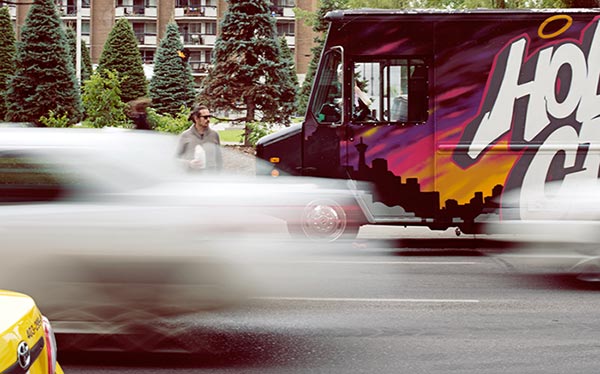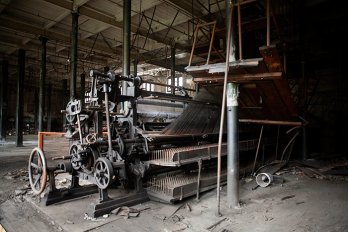When Charcut Roast House, one of Calgary’s most celebrated new restaurants, opened in early 2010, it took an idiosyncratic approach to fine dining. Meats were cured in house, the menu changed daily, and the food arrived at the table potted in Mason jars or splayed across cutting boards. The atmosphere was refined but relaxed, like a neighbourhood gastropub. Its co-chefs, Connie DeSousa and John Jackson, wanted Charcut to be a pillar of the community, but it occupied the ground floor of a swank downtown boutique hotel, stranded on a sterile corner across a busy commuter artery from the Calgary Tower, a poured concrete, nine-to-five sort of place. How could they connect with diners in a location that seemed so inhospitable?
The chefs came up with a simple idea: “Something underground and foodie” is how DeSousa described it. They would make a snack version of their colossal signature Share Burger, wrap it in foil, and sell it for five bucks out the kitchen’s back door. They only announced the project on Twitter and Facebook, summoning in-the-know burger lovers to gather in the alley behind the hotel in the afternoon or late evening. Once the crowd was large enough or the hour late enough, the kitchen staff announced a cut-off point, took a head count, and then made only enough—one per customer—to feed the anointed. And that’s how the word-of-mouth Alley Burger was born.
By the spring of 2011, as many as 350 patrons packed the narrow lane behind Charcut on Alley Burger nights, and one of the event’s first fans by then occupied the mayor’s office. Naheed Nenshi had occasionally used the late-night burgers for campaign sustenance and the gatherings themselves as impromptu voter meet-and-greets. As in most big Canadian cities, local bylaws to regulate restaurant licensing, street vending, and outdoor café seating were a tangled mess of contradictory requirements and overprotective restrictions; aside from a couple of hot dog stands, Calgary had no street food to speak of. Nenshi figured that was the best place to begin making changes. Setting aside the knotty legislation for later, he launched a pilot project outside established boundaries—something that would, he hoped, get his city hall staff and average citizens alike as engaged and hungry for more as the Alley Burger’s acolytes were. He chose an instrument that was already riding the fat part of a continental wave of breathless hype. That summer, Calgary would have a new fleet of food trucks.
The contemporary food truck movement—hip vendors serving up gourmet comfort food for budget-conscious customers drawn in droves by Twitter feeds and Facebook updates—originated in 2008 on the streets of Los Angeles, where a truck called Kogi BBQ started serving Korean barbecue wrapped in corn tortillas. Its founder, Roy Choi, was named one of America’s best new chefs in 2010 by Food & Wine magazine, unprecedented for a food truck operator; and word of his delectable short rib tacos and indefatigable multi-hour lineups swept across North America. By the summer of 2011, the trend was so widespread that in pioneering cities like LA, established chain restaurants such as Sizzler were launching trucks of their own.
Canadian cities have met the buzz with one of two responses, largely dependent on the tightness of local regulations and the willingness of their overseers to untangle them. Montreal, Toronto, and Ottawa remain mired in old bureaucratic muck, their streets mostly free of modern food trucks, due to superannuated permit bans or unfounded fears of competition with bricks-and-mortar restaurants. Toronto has seen a few new trucks this summer, but the city still restricts street parking, limiting vendors mainly to special events. In more flexible and welcoming regulatory environments, they have proliferated. There are hundreds of trucks and carts in Vancouver, offering up Korean tacos, Philly cheese steaks, and Vietnamese subs, among other treats; and a handful on the streets of Winnipeg. Hamilton has a bustling food truck scene, but in nearby St. Catharines forbidding ordinances until recently forced the lone pioneer to squat on the private parking lots of sympathetic local vineyards. The movement has come to national television via the Food Network’s Eat St. series faster than it has managed to cut through the country’s municipal red tape.
The streets of Calgary, meanwhile, have already hosted two visits from Eat St. On the first, it sampled three of the ten trucks in the fledgling 2011 program, including the Alley Burger truck, one of the first to sign on. When the series returned in 2012, there were thirty-three trucks to choose from, and the fleet already felt like a beloved local institution.
For the past 150 years, urban planning has primarily consisted of top-down master plans. First there were the singular utopian visions: garden cities, modernist radiant cities, one-size-fits-all subdivisions. Then came top-down solutions to the problems these schemes created, built out at similarly colossal scale: urban renewal high-rise razings, a proliferation of infill megaprojects (arenas and conference halls and casinos), stand-alone New Urbanist town centres. And now? With municipal budgets recessionary tight, young people flocking to dense urban cores, and new communications tools closing the distance between concept and implementation at digital speed, there are pop-up cafés, guerrilla gardens, de-pavings, reclaimed setbacks. Parking lanes have been turned into temporary parklets and seasonal patio space, gridlocked intersections have been reconfigured as plazas and public squares, farmers’ markets (even whole farms) have appeared in food deserts, and underpass parks have sprung up in the concrete jungle’s darkest gullies. Now, yes, there are food trucks. Now there is bottom-up urban design, small scale and provisional, incremental and easily replicable. Now there is collaboration, a vigorous open-source trade in ideas that proliferate rapidly on Twitter and YouTube and a thousand city-specific blogs.
Now there is “tactical urbanism,” a term coined by Mike Lydon, an energetic young urban designer from Brooklyn, where he is a principal with a consulting company called the Street Plans Collaborative. He apprenticed at Duany Plater-Zyberk & Company, the Miami-based firm from which Andres Duany and Elizabeth Plater-Zyberk launched the New Urbanism. Since the 1980s, DPZ and others have been bringing neo-traditional town plans, old-time front porches, and human-scale main streets to outer suburbia. (Two of the New Urbanism’s most ambitious projects have been built in Canada: McKenzie Towne in suburban Calgary, and Cornell Village in Markham, Ontario.)
But Lydon was more interested in his profession’s bright little sparks than in its fireworks: parking lots transformed into parks, temporary café seating to supplant parallel street parking, the rebirth of urban cycling—all the stuff Copenhagen design guru Jan Gehl liked to talk about when he explained why his hometown was considered one of the world’s most livable cities. When New York’s visionary transportation commissioner Janette Sadik-Khan worked with Gehl to block off sections of Broadway, turning Herald Square and Times Square into pedestrian plazas, they at first demarcated the space with cheap portable barriers and temporary seating. Lydon stumbled across a blog post that described Sadik-Khan’s strategy as “tactical,” and reckoned that it applied not just to Manhattan plaza reclamation but to all of the disparate interventions he was tracking, all of the tentative steps cities large and small were taking toward creating better urban space, less car-centred streets, more walkable neighbourhoods. A movement—even a street-scale, open-source one—needs a name, so Lydon chose “tactical urbanism,” then cobbled together a manual and posted it on his firm’s website as a free download.
“Tactical urbanism interventions,” the manual explains, “create a laboratory for experimentation.” They are not, however, guerrilla theatre, or art for art’s sake, or an ideological challenge like the détournements of the Situationists in mid-twentieth-century Paris. An act of tactical urbanism is “a deliberate, phased approach to instigating change,” local in scale, short term in duration, and low in risk, but if successful it suggests the possibility of something larger and more lasting. The food truck boom serves as a case in point. In many places, it began without full sanction, governed by time limits and spatial restrictions, but in city after city it has evolved into a permanent feature and a tool for quick, bureaucratically nimble urban reinvention. In many of the movement’s trail-blazing cities (LA and Portland, Oregon, for example), food truck operators have moved into the traditional restaurant business, or have partnered with other local initiatives aimed at complete street development and local food sales.
“Because these projects tend to be on a much smaller scale,” says Lydon, “they’re easier to replicate. They’re manageable. It’s hard to plan and build a bridge or a new light rail line without a ten-year process, funding, approvals, official permits, and so on. But if you’re going to make a small-scale change to an intersection and it works really well, then guess what? You might have a hundred more of those intersections around town. And that’s how you get a much wider, more systemic change in the city.”
Tactical urbanism functions in the city’s most permeable realm: that grey, formless area where grassroots action and community-scale projects find official partners, where underground interventions gain sanction, where a temporary experiment is fixed as permanent policy. Sometimes, tools developed without permission in one city become sanctioned projects in another, and sometimes a grassroots group will borrow another city’s top-down solution to solve its problems informally and at a local scale. In 2005, Rebar, an art and design studio in San Francisco, staged Park(ing) Day, turning a downtown parking spot into a miniature park; today the city is dotted with officially designated parklets based on its model, and the Park(ing) Day concept has been employed by activists and urban planners around the world. In the small town of Clear Lake, Iowa, a local café wanted a patio but lacked the needed space, so it received approval to install a wood pallet deck in its side alley that folds up like a Murphy bed to allow for garbage pickup and other city services—an improvised solution to a singular problem. A similar approach has been used along Toronto’s Yonge Street and Halifax’s Argyle Street to create summer patio seating and event spaces along temporarily widened sidewalks. To liven up its downtown core, the municipal government of Melbourne, Australia, obliged the developers of its high-rises to maintain “active laneways,” turning derelict side alleys into retail frontage and café space. In downtown Calgary, this model has been replicated for an unsanctioned alley party hosted by the newly refurbished Theatre Junction Grand, and for a city hall pilot project at the boisterous Chinatown Street Festival.
There is a nimbleness to tactical urbanism, an ease of implementation perfectly calibrated to its moment. For the first time in a century, downtowns across America are growing faster than suburbs. Young urbanites, many transplanted by choice after growing up in the suburbs, are buying fewer cars and more bikes, and smaller homes near better amenities. City budgets are more stressed than ever, but tactical urbanism’s tool kit is freely traded and ever evolving. It emphasizes results on the street now, which is not the thinking behind a long-term strategic plan. Lydon again: “If you can get something done tactically, short term, in the ground within six months, if you can continue the momentum from the planning process and people can see the change and get excited about supporting more, that’s an exciting approach.”
Consider the Better Block movement, which began in a Dallas neighbourhood called Oak Cliff, once a high-crime community that had begun to attract new businesses, including a bike shop. In the spring of 2010, the shop’s owners got together with other neighbourhood businesses and a citizens’ group called Go Oak Cliff to stage a street festival, choosing a main street that was lined with underperforming retail buildings, solid old urban stock that had been choked almost to death by high-speed commuter traffic, illogical zoning, and overzealous parking requirements. They knew the city would never give them permission to widen sidewalks, paint bike lanes, and plant street trees, so they did it all under the guise of an art installation. Using donated materials and volunteer labour, they set up a café on shipping pallets and installed trees in pots. They made their own bike lanes and narrowed the roadway to slow down traffic. There were pop-up businesses, including an art gallery, and the permanent bookstore had a banner weekend. The project’s leaders, Jason Roberts and Andrew Howard, took care to annotate a copy of the municipal code so that afterward they could show officials how many rules and regulations they’d had to break to create the most vibrant main street Oak Cliff had seen in generations. They also documented their work every step of the way, broadcasting the results in a concise, elegantly edited short film on YouTube.
Oak Cliff’s triumph went viral at the word-of-mouth speed of a Korean taco. Within months, Better Block projects were being replicated across the United States (more than thirty at last count), and Roberts and Howard have been invited to work with municipal governments in Dallas and beyond to permanently implement some of their initiatives. “They changed the way the city is looking at urban development, at least in some ways, for the long term, which is really powerful,” says Lydon. “I think that might have been a watershed moment in American urbanism.”
Downtown Calgary’s east side was until recently a decrepit, underdeveloped mess of vacant lots and abandoned buildings. It has been the subject of several grandiose master plans (one would have seen artificial canals dug out to create a Venetian vibe), but they amounted to almost nothing. The most recent plan, under the moniker the East Village, has come along more slowly. The section of the neighbourhood abutting the river has been redeveloped as the east end of the city’s bucolic RiverWalk; some smart new streets have been installed, with a condo showroom along one of them; a former Simmons mattress warehouse awaits new tenants; and the neighbourhood will eventually host the new National Music Centre. Still, most Calgarians have little reason to venture to the revitalized East Village.
In early August, James Boettcher, proprietor of the Fiasco Gelato food truck and creator of YYCFoodTrucks, the advocacy group that originally pushed for Nenshi’s pilot project, organized an anniversary party. He invited food truck operators to meet him for a lunchtime “frenzy” along a couple of quiet, undeveloped new blocks between the old Simmons warehouse and the river. Nineteen trucks showed up, creating a vibrant temporary pedestrian village. At some, hungry customers lined up for over half an hour, and people thronged the streets all afternoon. The newborn Village Brewery set up a festival stage and sold craft beers inside the Simmons Building. The long, low RiverWalk stone steps that line the Bow River provided extra seating for food truck customers.
For a few hours, and with little planning beyond a few tweets and a notice in the Calgary Herald, the East Village experienced a tactical urbanist intervention. It was a generously catered event, to be sure, but it wasn’t just about food. For one afternoon, hundreds of Calgarians saw the district’s full potential. They saw a vision of Calgary’s future worth pursuing. The event received wide, fawning media coverage. City committees and community open houses spend tedious years and thousands of dollars buying much less in the way of political capital. The city’s future starts small, but it won’t stay that way.
This appeared in the November 2012 issue.





